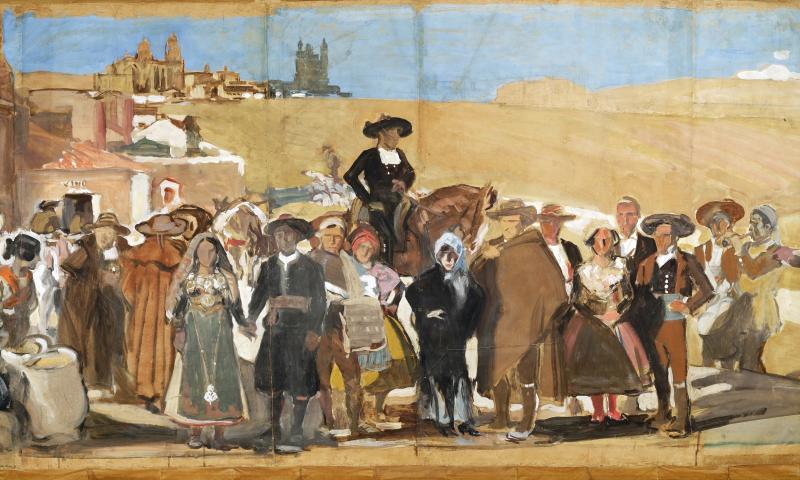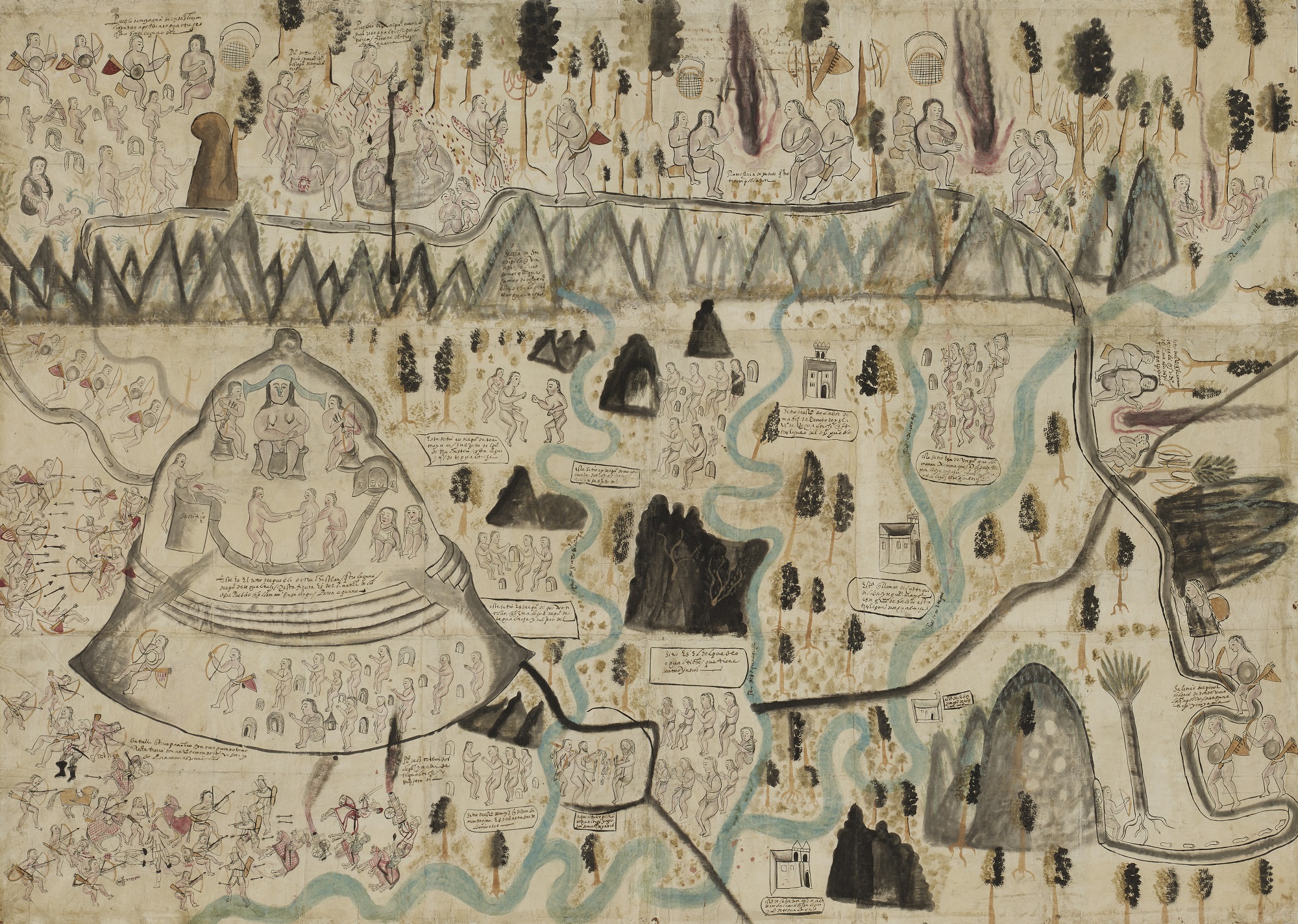Spain and the Hispanic World, Royal Academy review - a monumental survey | reviews, news & interviews
Spain and the Hispanic World, Royal Academy review - a monumental survey
Spain and the Hispanic World, Royal Academy review - a monumental survey
The refurbishment of New York's Hispanic Society provides a unique opportunity to see its treasures

Treasures from the Hispanic Society Museum & Library are displayed as a monumental survey of Spanish art from Antiquity to the 20th century. The new exhibition stands as testament to the extraordinary vision of its founder, Archer M Huntington.
Son of the American industrialist and railroad magnate Collis P Huntington, Archer accompanied his parents’ trips to the continent, finding sanctuary in European museums from the age of 12. He wrote of his visit to the Louvre in 1882, "I knew nothing about pictures, but I knew instinctively that I was in a new world." His interest soon outgrew just pictures, and would lead to the assembly of 150 Spanish-themed objects of metal work, maps, sculptures, and paintings now on display in the Royal Academy’s main gallery.
His founding of the Hispanic Society in 1904 satisfied a personal desire to amass an important collection. It also demonstrated his alignment and understanding of Spanish culture at a time when the average American held European art in contempt. Archer wasn’t swayed by this disdain and pursued his idealised views of Spain as an ode to the country. His growing collection was curbed by the outbreak of the First World War; a 10th century ivory box from Cordoba and a world map of 1526 by Juan Vespucci were his last acquisitions. The map signals the dawn of the Age of Exploration and the beginning of Hispanic culture. As the final piece of Archer’s puzzle it stands to unify the collection. All works on display can relate to this one image, their journeys charted and their origins discovered.
The Italian explorer Amerigo Vespucci travelled to the New World on behalf of Spain in 1499, reaching the coast of Venezuela. In a room dedicated to the colonial art of Latin America, Vespucci’s incomplete map of the world stretches across a wall. Its uneven texture mimics the topographical lines of a walker’s guide and with it, contains the world on a single sheet. The caste paintings of Juan Rodríguez Juárez on the adjoining walls offer a stark reality to the expansion of Europe and the fashionable obsession with racial purity and charting. The exhibition also offers explicit confluences of Spanish and South American practice (pictured above: Map of Tequaltiche, 1584). Paintings from the Cusco school reimagine Christian imagery through ornate local fabrics, and present these works in engraved frames with pearl inlay. In the same room, an image by Nicolás de Correa depicts the Wedding at Cana as an enconchado, an oil painting inlaid with iridescent mother-of-pearl. This method emerged in Mexico during the 17th century and carried luxury status.
The exhibition also offers explicit confluences of Spanish and South American practice (pictured above: Map of Tequaltiche, 1584). Paintings from the Cusco school reimagine Christian imagery through ornate local fabrics, and present these works in engraved frames with pearl inlay. In the same room, an image by Nicolás de Correa depicts the Wedding at Cana as an enconchado, an oil painting inlaid with iridescent mother-of-pearl. This method emerged in Mexico during the 17th century and carried luxury status.
The vision of the Hispanic Society culminates in an ambitious work, a sketch for which is shown in the last room (main picture). In 1911 Archer Huntingdon commissioned the prized Spanish painter Joaquín Sorolla to decorate a room at the Hispanic Society. The resulting 14 murals came to be known as the Vision of Spain, 1911-1919; a layered townscape depicting regional cultures through figures, costumes and traditions. Sorolla used gouache paint and large, kraft paper spools that could be unfurled to any length; in fact, his grand vision reached its limit, exceeding the space available. He had originally hoped to include the regions of Mallorca, the Canaries, Africa, and Portugal. This expressionist blueprint reads like a novella of Huntington and Sorolla’s single vision of Spain. Sadly, Sorolla died before the series could be installed in 1926.
In the same year Sorolla produced a vast portrait of Louis Comfort Tiffany, the glass maker and first design director of his father’s company. Painted in the grounds of his Long Island estate, Tiffany is the true artist at work, complete with red paint stains down his trouser leg. Shown in his summer linens with a Gatsby quantity of pastel flowers, Sorolla’s chocolate box hides a mastery of colour and tone. With the exception of the cuff, every white is mixed with another colour. This balance of pigment is irresistible and demands closer looking, a steady thrum of texture and colour.
The Hispanic Society of America is set to reopen in New York later this year with an exhibition dedicated to the work of Goya.
rating
Explore topics
Share this article
The future of Arts Journalism
You can stop theartsdesk.com closing!
We urgently need financing to survive. Our fundraising drive has thus far raised £49,000 but we need to reach £100,000 or we will be forced to close. Please contribute here: https://gofund.me/c3f6033d
And if you can forward this information to anyone who might assist, we’d be grateful.

Subscribe to theartsdesk.com
Thank you for continuing to read our work on theartsdesk.com. For unlimited access to every article in its entirety, including our archive of more than 15,000 pieces, we're asking for £5 per month or £40 per year. We feel it's a very good deal, and hope you do too.
To take a subscription now simply click here.
And if you're looking for that extra gift for a friend or family member, why not treat them to a theartsdesk.com gift subscription?
more Visual arts
 'We are bowled over!' Thank you for your messages of love and support
Much-appreciated words of commendation from readers and the cultural community
'We are bowled over!' Thank you for your messages of love and support
Much-appreciated words of commendation from readers and the cultural community
 Folkestone Triennial 2025 - landscape, seascape, art lovers' escape
Locally rooted festival brings home many but not all global concerns
Folkestone Triennial 2025 - landscape, seascape, art lovers' escape
Locally rooted festival brings home many but not all global concerns
 Sir Brian Clarke (1953-2025) - a personal tribute
Remembering an artist with a gift for the transcendent
Sir Brian Clarke (1953-2025) - a personal tribute
Remembering an artist with a gift for the transcendent
 Emily Kam Kngwarray, Tate Modern review - glimpses of another world
Pictures that are an affirmation of belonging
Emily Kam Kngwarray, Tate Modern review - glimpses of another world
Pictures that are an affirmation of belonging
 Kiefer / Van Gogh, Royal Academy review - a pairing of opposites
Small scale intensity meets large scale melodrama
Kiefer / Van Gogh, Royal Academy review - a pairing of opposites
Small scale intensity meets large scale melodrama
 Jenny Saville: The Anatomy of Painting, National Portrait Gallery review - a protégé losing her way
A brilliant painter in search of a worthwhile subject
Jenny Saville: The Anatomy of Painting, National Portrait Gallery review - a protégé losing her way
A brilliant painter in search of a worthwhile subject
 Abstract Erotic, Courtauld Gallery review - sculpture that is sensuous, funny and subversive
Testing the boundaries of good taste, and winning
Abstract Erotic, Courtauld Gallery review - sculpture that is sensuous, funny and subversive
Testing the boundaries of good taste, and winning
 Edward Burra, Tate Britain review - watercolour made mainstream
Social satire with a nasty bite
Edward Burra, Tate Britain review - watercolour made mainstream
Social satire with a nasty bite
 Ithell Colquhoun, Tate Britain review - revelations of a weird and wonderful world
Emanations from the unconscious
Ithell Colquhoun, Tate Britain review - revelations of a weird and wonderful world
Emanations from the unconscious
 Rachel Jones: Gated Canyons, Dulwich Picture Gallery review - teeth with a real bite
Mouths have never looked so good
Rachel Jones: Gated Canyons, Dulwich Picture Gallery review - teeth with a real bite
Mouths have never looked so good
 Yoshitomo Nara, Hayward Gallery review - sickeningly cute kids
How to make millions out of kitsch
Yoshitomo Nara, Hayward Gallery review - sickeningly cute kids
How to make millions out of kitsch
 Hamad Butt: Apprehensions, Whitechapel Gallery review - cool, calm and potentially lethal
The YBA who didn’t have time to become a household name
Hamad Butt: Apprehensions, Whitechapel Gallery review - cool, calm and potentially lethal
The YBA who didn’t have time to become a household name

Add comment